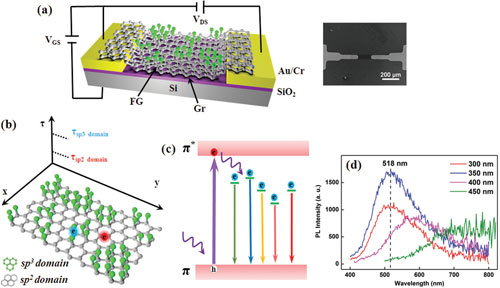| Posted: Jun 09, 2017 | |
Developing high-performance broadband graphene-based photodetectors(Nanowerk News) An international team of researchers has reported a van der Waals heterostructure photodetector consisting of graphene and its fluorine-functionalized derivative that enhances the photoresponse of graphene with broadband sensitivity. |
|
| In contrast to photodetectors operating at a specific wavelength range, broadband photodetectors with photoresponse to a much wider spectrum and spectrally distinctive offers advantages over traditional panchromatic and multispectral imagery due to the wealth of sufficient information held in the broad spectral domain. | |
| For instance, ultraviolet-visible (UV–vis) photodetectors can meet the demands on astronomical detection, wide spectral switches, or memory storage; visual light and near-infrared (IR) photodetectors are widely used in consumer electronics, video recording, and remote sensing; multiband mid-IR photodetectors have attracted interest due to their numerous exciting applications, such as in surveillance, medical diagnostics, bioimaging, and navigational aids. | |
| Reporting their findings in Advanced Materials ("A Broadband Fluorographene Photodetector"), the team demonstrates that, in contrast to other graphene-based photodetectors, the van der Waals heterostructure efficiently improves the device performance while keeping the broadband photoresponse of graphene. | |
| Furthermore, they demonstrate a prototype device yielding exceptional photoresponsivities over a widebroad spectral range. | |
 |
|
| Device structure and PL characterization. a) Schematic FG/Gr photodetector structure and the top-view SEM image. b,c) Schematic sp3 and sp2 domains on FG with indicated trapped carrier lifetime (b) and corresponding optical transitions (c). d) PL spectra of the FG at different excitation wavelengths. (© Wiley-VCH Verlag) (click on image to enlarge) | |
| The team writes that the consistent performance of the device shows a broadband photoresponse from UV to mid-IR with high detectivity and moderate switching speed, which can be further improved by engineering the nature of the sp3 site. | |
| The authors conclude that their proposed scheme paves the way toward implemention of high-performance broadband graphene-based photodetectors. |
 By
Michael
Berger
– Michael is author of three books by the Royal Society of Chemistry:
Nano-Society: Pushing the Boundaries of Technology,
Nanotechnology: The Future is Tiny, and
Nanoengineering: The Skills and Tools Making Technology Invisible
Copyright ©
Nanowerk LLC
By
Michael
Berger
– Michael is author of three books by the Royal Society of Chemistry:
Nano-Society: Pushing the Boundaries of Technology,
Nanotechnology: The Future is Tiny, and
Nanoengineering: The Skills and Tools Making Technology Invisible
Copyright ©
Nanowerk LLC
|
|
|
Subscribe to a free copy of one of our daily Nanowerk Newsletter Email Digests with a compilation of all of the day's news. |
